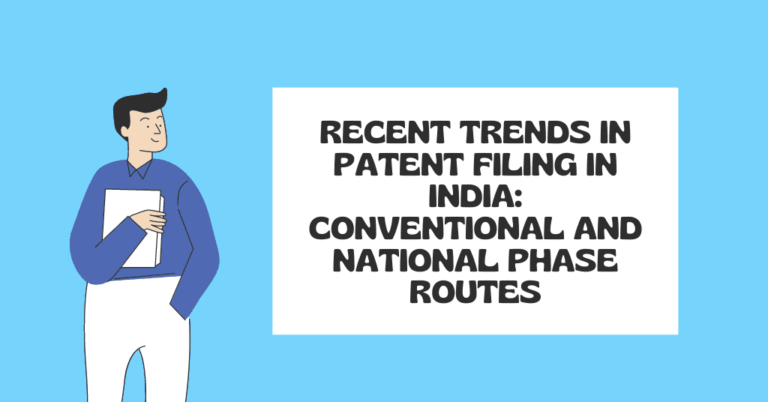The landscape of patent filing in India has witnessed significant changes over recent years, influenced by global economic shifts, advancements in technology, and evolving legal frameworks. Two primary routes dominate the patent filing process in India: the conventional route and the national phase route under the Patent Cooperation Treaty (PCT). Understanding recent trends in these routes provides valuable insights for inventors, businesses, and legal professionals.
Conventional Route Trends
The conventional route, which involves filing a patent application directly with the Indian Patent Office within 12 months of the priority date, has seen a steady increase in activity. This route is often favoured by domestic applicants and businesses seeking to protect innovations promptly within the country.
Growth in Domestic Applications: There has been a noticeable rise in patent applications from Indian inventors and small to medium enterprises (SMEs). This trend is fuelled by increased awareness of intellectual property rights and government initiatives such as the “Startup India” campaign, which offers reduced filing fees for startups.
Technological Advancements: Sectors like biotechnology, pharmaceuticals, information technology, and artificial intelligence have dominated recent filings. Innovations in these areas reflect India’s growing prowess in high-tech and research-driven industries.
Streamlined Processes: The Indian Patent Office has made efforts to streamline the patent examination process, reducing the time taken to grant patents. Initiatives like the expedited examination for startups and the electronic filing system have contributed to more efficient processing of applications.
National Phase Route Trends
The national phase route, allowing international applicants to enter India’s patent system under the PCT within 31 months from the priority date, continues to be a popular choice for foreign entities seeking protection in India.
Increase in International Filings: India’s robust market potential and favourable IP environment have led to an increase in national phase entries. Companies from the United States, Europe, Japan, and China are prominent users of this route, reflecting India’s importance as a key market for global innovation.
Diverse Technological Domains: Similar to the conventional route, the national phase route has seen a surge in applications in advanced technology sectors. Notably, there has been significant activity in renewable energy technologies, medical devices, and consumer electronics.
Legal and Regulatory Developments: Recent amendments in Indian patent laws, aimed at harmonizing with international standards, have made the national phase route more attractive. The introduction of measures like the Patent Prosecution Highway (PPH) with Japan has facilitated faster processing of applications, thereby encouraging more international filings.
Analysis of recent filing trends for both routes
Recent filing trends for patents in India, through both the conventional and national phase routes, indicate a robust growth in domestic and international patent activity. The conventional route has seen a rise in applications from Indian inventors and SMEs, spurred by government initiatives and heightened IP awareness, with notable filings in biotechnology, IT, and AI sectors. Concurrently, the national phase route under the Patent Cooperation Treaty (PCT) has attracted increasing international interest, particularly from the US, Europe, Japan, and China, driven by India’s expanding market potential and improved regulatory environment. Technological advancements and streamlined processes, such as expedited examinations and electronic filing, have further enhanced the appeal of patenting in India.
Impact of technological advancements on filing strategies
Technological advancements are significantly reshaping patent filing strategies, compelling inventors and companies to adopt more sophisticated and proactive approaches. The rise of cutting-edge fields such as artificial intelligence, biotechnology, and renewable energy has led to a surge in complex and interdisciplinary inventions, necessitating comprehensive prior art searches and strategic global filings to secure broad and robust protection. Additionally, advancements in digital tools and patent analytics enable applicants to identify optimal filing routes, anticipate market trends, and streamline the drafting and submission processes. As a result, the integration of technology into IP management not only enhances the efficiency and precision of patent filings but also strengthens the strategic positioning of patents in a competitive marketplace.
Predictions for future trends in patent filings
Future trends in patent filings are likely to be characterized by an increasing emphasis on emerging technologies and sustainability. Innovations in areas such as artificial intelligence, quantum computing, biotechnology, and green technologies are expected to dominate patent landscapes, driven by ongoing research and global efforts to address environmental challenges. Additionally, the patent filing process will continue to evolve with advancements in digital tools, such as AI-powered patent analytics and blockchain for secure and transparent IP management, making the process more efficient and accessible. Geographic trends may also shift, with developing countries like India and China playing a more prominent role in global patent activity. As businesses and inventors seek to protect their innovations in a rapidly changing world, strategic, international, and collaborative patent filings will become increasingly crucial.
Challenges and Opportunities
Despite the positive trends, several challenges remain. The backlog of pending applications, although reduced, still poses a hurdle. Additionally, ensuring consistent quality in patent examination is critical as the volume of applications grows.
However, these challenges also present opportunities. Continued investments in digitization, capacity building within the Patent Office, and fostering a more innovation-friendly ecosystem can further enhance India’s position as a global patent filing destination.
Conclusion
The evolving landscape of patent filing in India, encompassing both the conventional and national phase routes, highlights a dynamic interplay between domestic innovation and international interest. The conventional route has become increasingly popular among Indian inventors and SMEs, driven by government initiatives and a growing awareness of intellectual property rights. Meanwhile, the national phase route under the PCT attracts substantial international filings, reflecting India’s significance as a key market for global innovation. Technological advancements are reshaping filing strategies, enabling more efficient and strategic patent management. Future trends are expected to focus on emerging technologies and sustainability, with India poised to play an even more prominent role in the global patent arena. While challenges such as application backlogs and quality consistency remain, they also present opportunities for further improvements. By continuing to invest in digitization and capacity building, India can enhance its position as a leading destination for patent filings, benefiting inventors and businesses worldwide.







